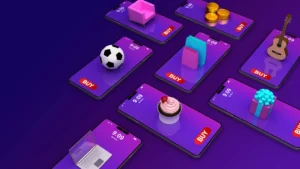To structure the description of current practices for 2024, we propose to examine the mobile development platforms from the perspective of individual mobile application developers. We’ll categorize the platforms based on three main components. First, developers utilize development tools to build their mobile applications. Second, they publish their applications on a portal, where consumers can download them onto their mobile devices. This model, adapted for 2024, encompasses developers, application portals, consumers, and all processes related to publishing and purchasing mobile applications.
In 2024, the landscape of mobile development continues to evolve rapidly, with emerging technologies and trends shaping the industry. Developers are exploring new avenues for creating innovative and immersive mobile experiences, leveraging advancements in AI, AR/VR, and IoT. Additionally, the demand for mobile applications with enhanced security, privacy features, and seamless integration with wearable devices is on the rise. As developers adapt to these shifting trends, collaboration and knowledge-sharing within the mobile development community become increasingly vital. By staying informed about the latest technologies and industry developments, developers can effectively navigate the dynamic landscape of mobile app development in 2024 and beyond.

Development Tools:
Software Development Kit (SDK): The Backbone of Mobile Development
- Introduction to the essential components within an SDK.
- Varied approaches of platforms regarding SDK accessibility.
- Contrasting bazaar (open-source) and cathedral (closed) development models.
SDK Disclosure Strategies: Open Source vs. Closed Source
- In-depth examination of platforms’ choices in sharing SDK source code.
- Impact on third-party developers and the collaborative construction of platform structures
Central to every development platform is its software development kit (SDK), which enables third-party developers to deliver applications running on the platform. Such a kit can include, among other things, libraries, debuggers, and handset emulators. Existing platforms have taken different approaches when it comes to sharing their SDK with developers. Some have chosen to restrict access as much as possible, whereas others have chosen to disclose the entire source code of their SDK and OS. Using the terminology introduced by Raymond, we call a bazaar an open-source platform, where any third-party developer can access the entire platform with no or little restrictions and contribute to the construction of its structure. Conversely, we call a cathedral a closed platform, where most of the code is hidden from developers, and an almighty architect plans every inch of the platform’s construction.
Portals:
Application Portals: Bridging Developers and Consumers
- The pivotal role of mobile portals in the application distribution process.
- Predictions and trends regarding the number and consolidation of application portals.
Decentralized Portal Approach: A Diverse Marketplace
- Exploration of decentralized portal models adopted by Nokia, Linux, Microsoft, and LiMo.
- The balance between developer freedom and challenges for consumers in a varied portal landscape.
In order for applications to pass from developers to consumers, an application portal must be created. Mobile portals are considered an essential element in the mobile application distribution process since they play the role of an intermediary between developers and consumers. Some scholars predicted that the number of portals would increase, whereas others predicted that the portal market would consolidate given time. In the current market, both phenomena are present. Some platforms use a centralized single point of sale strategy, and others use a decentralized multiple points of sale strategy. A decentralized portal approach is adopted by Nokia, Linux, Microsoft, and LiMo. Developers can freely upload their applications on any third-party portal, as there is no centralized policy. In this model, all portal providers can freely compete to gain customers and applications. The downside for the consumer is that the great variety of portals does not provide a comprehensive oversight of existing applications.
Platform Integration:
Platform Integration Levels: From Core OS to Complete Distribution Control
- Classification of platforms based on their level of integration.
- Examination of full integration, portal integration, device integration, and no integration models.
Full Integration Prowess: Apple and Nokia Case Studies
- Detailed insights into Apple’s strict control from device manufacturing to AppStore.
- Nokia’s similar strategy in manufacturing, providing portals, and delivering content via OVI.
Some platforms focus on their core business, which is to provide an OS with programming support for developers, whereas others integrate the entire distribution process. We classify platforms according to their level of integration similarly to, but instead of taking into account the whole value chain, we focus on the distribution process. We identified four different types of integrations, namely full integration, portal integration, as well as device integration and no integration. Platforms with full integration have strict control over every step of the distribution model from device manufacturing to application publishing. Apple and Nokia exhibit such strong integration. Apple produces the device on which its OS runs, namely the iPhone, and it owns the unique authorized portal for mobile applications, namely the AppStore. Furthermore, Apple also plays the role of a content provider with the iTunes store available on the iPhone. Similarly, Nokia manufactures its phones and provides an application portal as well as other content via its OVI3 portal.
Towards Portal Centralization:
Evolution of Mobile Application Portals: Pre and Post App Store Era
- Historical perspective on mobile application portals before and after Apple’s App Store.
- The transformative impact of the App Store on the perception and revenue potential of mobile applications.
Leadership Effect: Apple’s Success and Industry Adaptations
- CEO Steve Jobs’ revelations on App Store revenue and download statistics.
- Traditional platforms like Nokia, RIM, and Microsoft adapting and moving towards portal centralization.
Prior to the introduction of Apple’s App Store and more recently Google’s Android Market, platforms did not have a central portal. With the introduction of its App Store, Apple has proven that a mobile application market should not be underestimated and can represent an important revenue stream. According to CEO Steve Jobs, the App Store has generated revenue of a million dollars a day in its first month of existence. There are currently 15,000 applications on the portal, which have been downloaded a total of 500 million times. Note that these figures grew by 50% in the last month. Following Apple’s lead, traditional platforms like Nokia, RIM, and Microsoft seem to be moving in this direction. Nokia is pushing its OVI portal, and RIM has developed its own Application Center. Microsoft is also planning to launch its own version of the AppStore called SkyMarket with the next version of Windows Mobile (WM7).
In conclusion, the landscape of mobile development tools, portals, and platform integration is continually evolving. The shift towards portal centralization, spurred by the success of platforms like Apple, indicates a trend that traditional players are adapting to. As the industry matures, the balance between open-source and closed platforms, as well as the dynamics of portal strategies, will continue to shape the mobile application ecosystem.





Leave a Reply